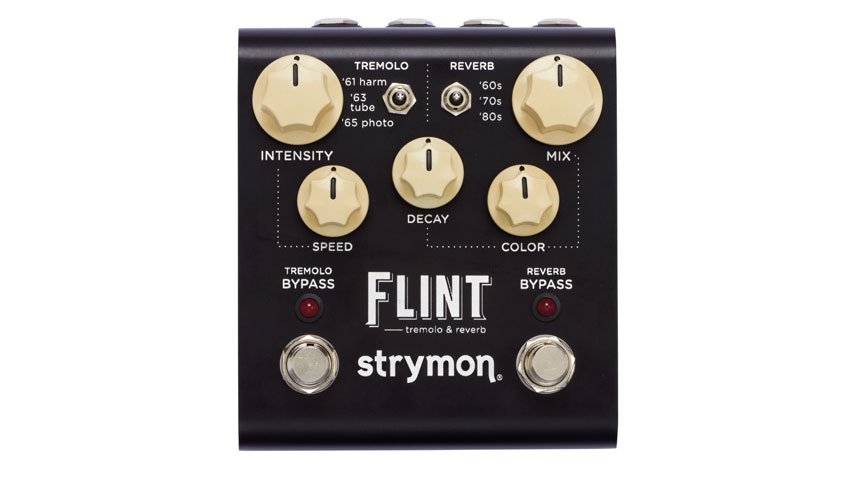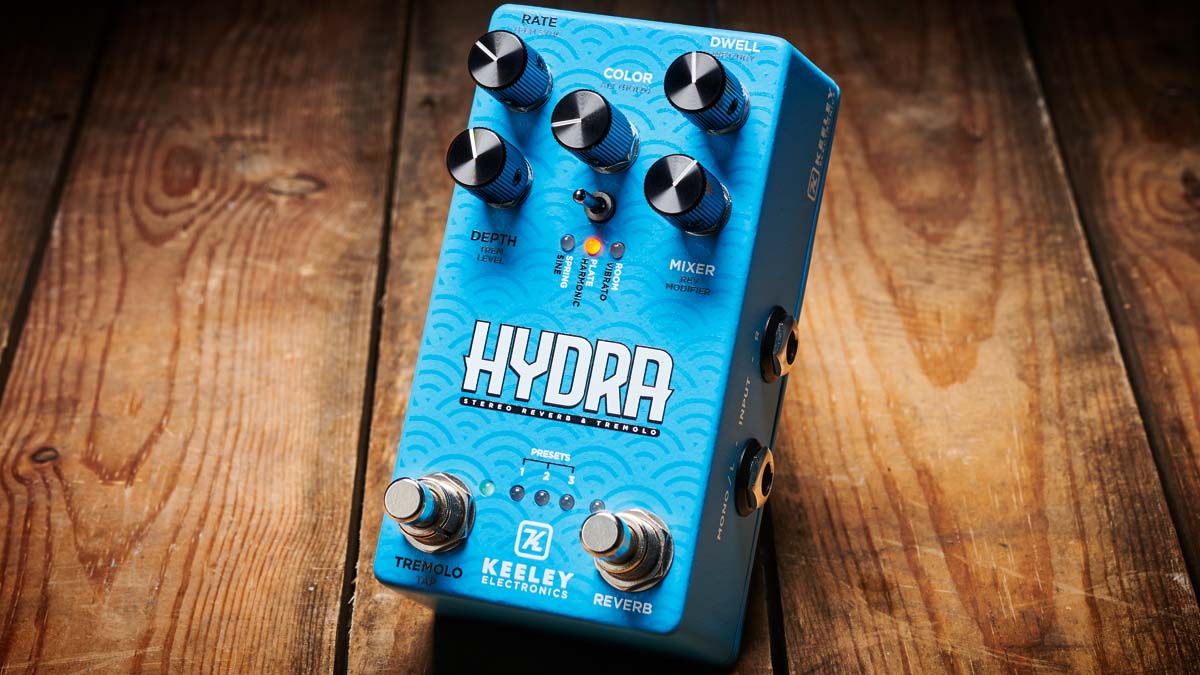MusicRadar Verdict
Keeley packs so many features into such a small enclosure, but this reverb and tremolo never feels crowded, presenting players with a classic effects combo with a modern twist.
Pros
- +
Excellent tremolo and reverb tones.
- +
It's a space-saver.
- +
Heaps of controls.
- +
Presets.
- +
Tap tempo for the tremolo.
- +
Expression pedal in.
Cons
- -
Some players want something to go between trem and 'verb.
MusicRadar's got your back
What is it?
Reverb and tremolo is a classic effect combination. Their union was consecrated in vintage Fender guitar amplifiers, but in recent years the pairing has popped up in units from the likes of Strymon, Source Audio, Mr Black and Fender.
The combination is a stompbox category of its own. Here we are looking at Keeley Electronics' new Hydra pedal, but the Oklahoma effects specialist has already made a splash in the market with the Verb-O-Trem. What makes the Hydra that different?
Well, unlike the Verb-O-Trem, the Hydra is a dual-footswitch design, and it packs a lot into that compact blue enclosure.
With the reverb and tremolo sections having their own dedicated footswitch, the Hydra features controls for Rate, Depth, Dwell, Mixer and Color/Mode, with a three-way switch that selects reverb type (Spring, Room, Plate) and tremolo type (Sine, Harmonic, Vibrato) with the Color knob depressed.

A trio of red LEDs let you know which of the three preset slots you have active, while two blue LEDs immediately adjacent to each footswitch lets you know which effect is on at the time. Helpfully, the tremolo LED flashes at the tempo of the pulse.
You can set the tremolo rate with a neat tap-tempo mode. Just hold down the tremolo footswitch for a second or so and then you can tap out your tempo. Not to be outdone, if you depress and hold the reverb footswitch you can freeze the input signal for infinite sustain. Pretty cool.
Furthermore, you can run the Hydra in mono or stereo, run the reverb wet/dry setup for the reverb, and pan the tremolo sync’d or wet/dry. Sure, there are a lot of features here but it all makes sense once you get going.
Performance and verdict
Use the Rate and Depth controls to adjust the tremolo. Dwell controls how long you want the reverb trail while the Mixer controls the reverb level.
While the Color knob's primary function is to adjust the tone on the reverb trails, offering plenty of range, it leads a double life as a mode switch: hold it down and you can access secondary functions on the other four knobs. Listed in grey underneath the respective knob, you've got Trem Sync for setting up your stereo tremolo options.
There is a Trem Level control that can offer a 6dB boost to compensate for the perceived drop in volume with tremolo, while Wet/Dry offers you some stereo options for the reverb.
Reverb Adjustment is very interesting. You can age the spring reverb mode, add an octave-up shimmer to the plate reverb, and turn to make the room reverb huge. Some of these sounds used in tandem with the tremolo are hugely musical.

• Strymon Flint
Three trem flavours cover plenty of bases from the choppy '65 to the more rounded '63 and the delightful harmonic tremolo with its hint of rotary speaker or Uni-Vibe.
• Fender Tre-Verb
With its muddy, vintage tone and washiness on longer settings, we enjoyed the ’63 most for atmospheric post-metal riffs, but pulling back the dwell and blend adds fatness and colour to Tele-pickup blues licks as well.
Whichever way you set the Hydra up, some very cool tones come out of it. The Sine Wave tremolo evokes vintage guitar amps, with a smooth pulse offering the most conventional tremolo sound. The Harmonic tremolo is deep and heady. Vibrato might be a perennially under-appreciated effect but it is hard not to love this one.
There are more outré units on the market but what the Hydra does well is present the classic sounds with a huge degree of flexibility, before adding a refreshing spritz of secondary functions that make it a no-brainer for the last pedal in the chain. Lovely stuff. And you can connect an external expression pedal, too.
MusicRadar verdict: Keeley packs so many features into such a small enclosure, but this reverb and tremolo never feels crowded, presenting players with a classic effects combo with a modern twist.
Hands-on demos
Guitarist
Keeley Electronics
Rabea Massaad
Mike Hermans
Specifications
- ORIGIN: USA
- TYPE: Tremolo and reverb pedal
- FEATURES: Switchable true or buffered trails bypass, tap tempo, infinite hold function, expression pedal capability
- CONTROLS: Rate, Depth, Color/Mode switch, Dwell, Mixer, selector switch, Tremolo footswitch, Reverb footswitch
- CONNECTIONS: Standard inputs (L/Mono, Right), standard outputs (Stereo, Mono), TRS EXP pedal, Remote switching input
- POWER: 9V DC adaptor, 115mA
- DIMENSIONS: 73 (w) x 124 (d) x 61mm (h)
- CONTACT: Keeley Electronics
MusicRadar is the number one website for music-makers of all kinds, be they guitarists, drummers, keyboard players, DJs or producers...
- GEAR: We help musicians find the best gear with top-ranking gear round-ups and high-quality, authoritative reviews by a wide team of highly experienced experts.
- TIPS: We also provide tuition, from bite-sized tips to advanced work-outs and guidance from recognised musicians and stars.
- STARS: We talk to musicians and stars about their creative processes, and the nuts and bolts of their gear and technique. We give fans an insight into the craft of music-making that no other music website can.
“A synthesizer that is both easy to use and fun to play whilst maintaining a decent degree of programming depth and flexibility”: PWM Mantis review
“I feel like that song had everything we needed to come back with”: Bring Me The Horizon’s Lee Malia on Shadow Moses, its riff and the secrets behind its tone, and why it was the right anthem at the right time
“I said, ‘Are we sure we can write a song about death?’”: The story of Mike + The Mechanics' classic No.1 The Living Years











